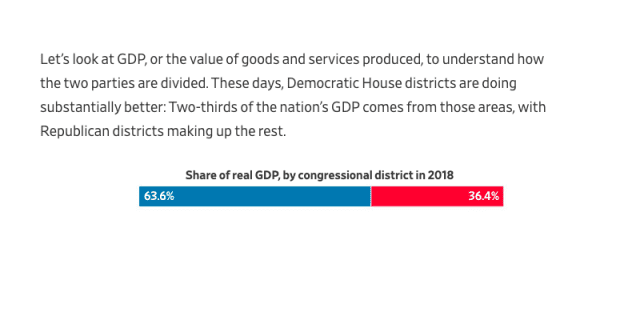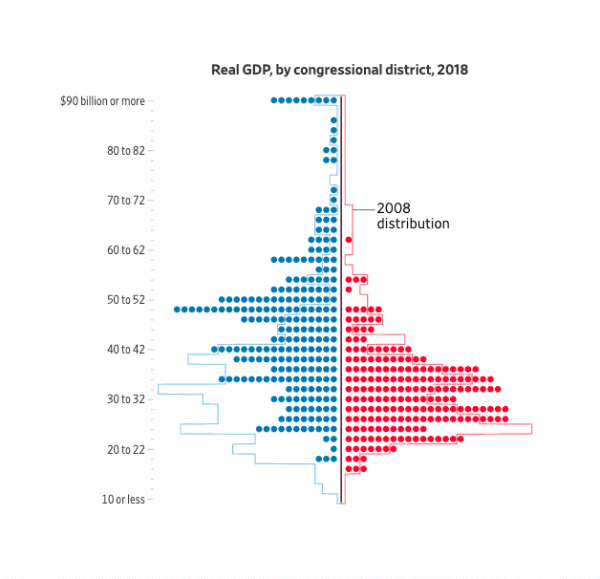One Country, Two Nations

Take a look at this:
 Here’s a link to a great graphics presentation, “Red Economy, Blue Economy,” by the Wall Street Journal illustrating how far apart we have grown as a national economically.
Here’s a link to a great graphics presentation, “Red Economy, Blue Economy,” by the Wall Street Journal illustrating how far apart we have grown as a national economically.
The bottom line is that we have become a nation of haves and have-nots. Of people who are falling behind economically, and people who are moving ahead. The Democratic Party represents the economic winners; the Republican Party, the economic losers. This graphic shows how much things have changed in a decade. The Democratic districts got richer, and the Republican districts got poorer:

The final slide says:
Why does this matter?
“When folks have less in common with one another, it’s hard to expect that they’re going to see the problem the same way,” said Roger Johnson, president of the National Farmers Union, “let alone recognize that a problem exists.”
Please do watch the whole thing. (There’s no audio.) It will only take a minute or two, but it’s really illuminating.
You can see why the economic losers are so angry, and feel so robbed of dignity. (This, by the way, mirrors the geographic Brexit divide in the UK.) Those who have been left behind by the information and tech economy really are suffering economically, and the people who left them behind literally did, moving to the blue districts where the jobs are. In the charts, you see that the blue districts have far more college-educated people.
One thing that the charts don’t tell us, but I’d be interested to know, is to what extent blue areas draw college educated people working in the information economy because that’s where the jobs are, and to what extent social and cultural factors draw them there. I ask because I wonder if a Southern or Midwestern city that invested heavily in building infrastructure for the information/tech economy would have a real chance at holding on to its college grads if the culture there remains conservative relative to the big blue cities.
I know that when I left college, there was nothing that Baton Rouge (where I live now) could have done to hold me. Partly it was economic, but my desire to see the world was overwhelmingly cultural. Washington DC, greater Miami, and New York City are great places to live if you’re single, or newly married without children, and I had a blast doing it. But you get older, start thinking about building for your kids and for your own retirement, and you might find that what the non-glamorous cities you left behind have is what your family needs. (N.B., I lived in Dallas for six years, and I think it does a great job of being a middle ground between having the great things about a big city while still holding on to some conservative values.)
Anyway, the WSJ piece makes it clear that economically, the Democrats are the party of the rich and the rising middle classes, and the Republicans are the party of the working class and the downwardly mobile middle classes. Of course race plays into this too, though that isn’t measured by the WSJ piece. We can say, then, that the Democrats represent the economic winners and racial minorities, while the Republicans represent the economic losers and whites.
With regard to that Roger Johnson quote, I wonder if this explains why none of the Democratic debates so far have focused to any degree on religion. Blue America people — at least in the media and in the political class — don’t know that religion exists. They don’t see it. They don’t even see it in their own cities.
When I worked for the NYPost in the early 2000s, I proposed writing a column about Evangelicals in the boroughs. My editor at the time shot it down, saying, “New York is not a religious city.” He really thought that was true. It wasn’t even close to true, but in his social class, it was true. We lived in adjacent neighborhoods in Brooklyn, and I knew for a fact that there were several established churches, a mosque, two synagogues, and a storefront Pentecostal church within minutes of his front door. But he was secular, and didn’t see them.
Anyway, the WSJ charts show why the Republican Party is going to become more populist — there will be no restoration of the pre-Trump GOP; watch Sen. Josh Hawley rise — and the Democratic Party is going to become more bourgeois. Of course both parties will have their own outliers, but that’s going to be the mainstream of the parties.
By the way, if you haven’t seen it, Chris Arnade’s book Dignity is a fantastic read on all this.